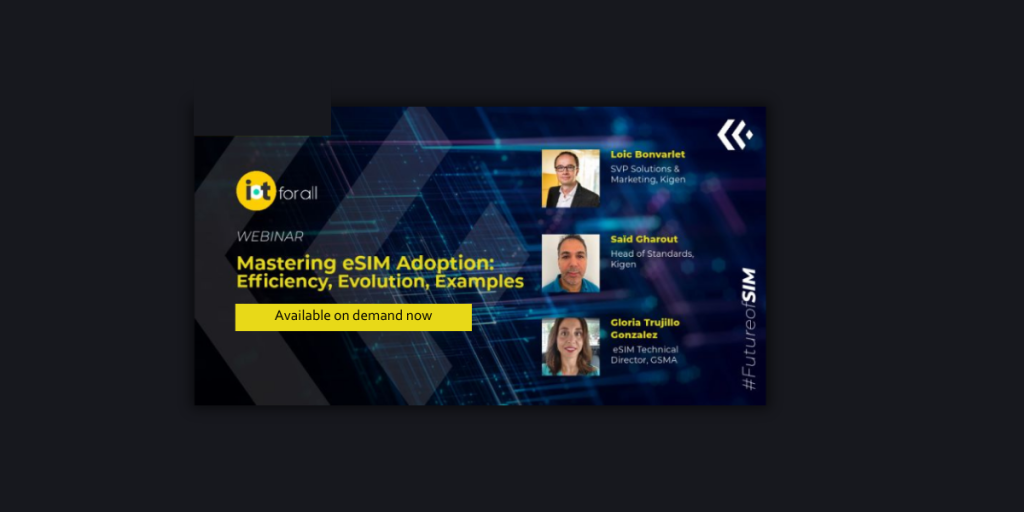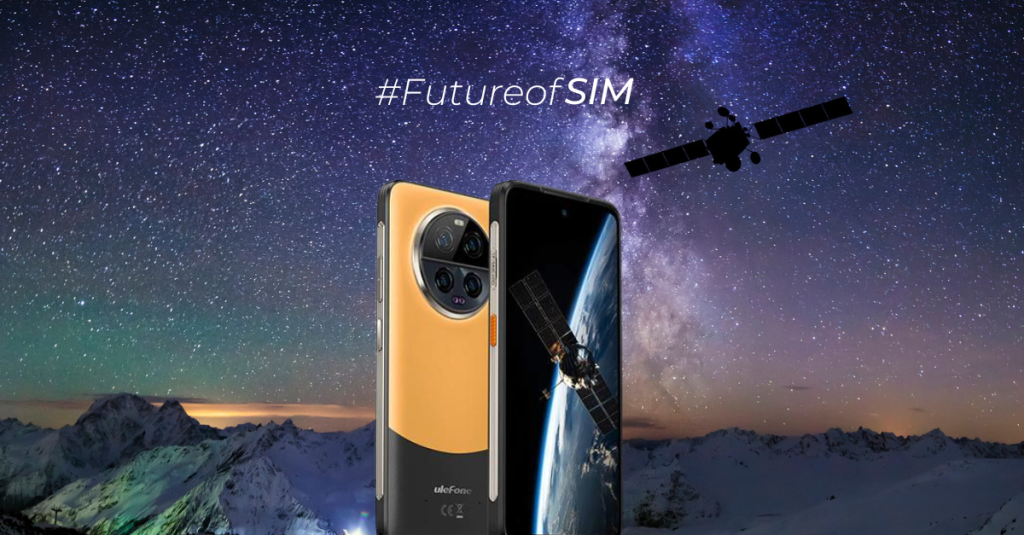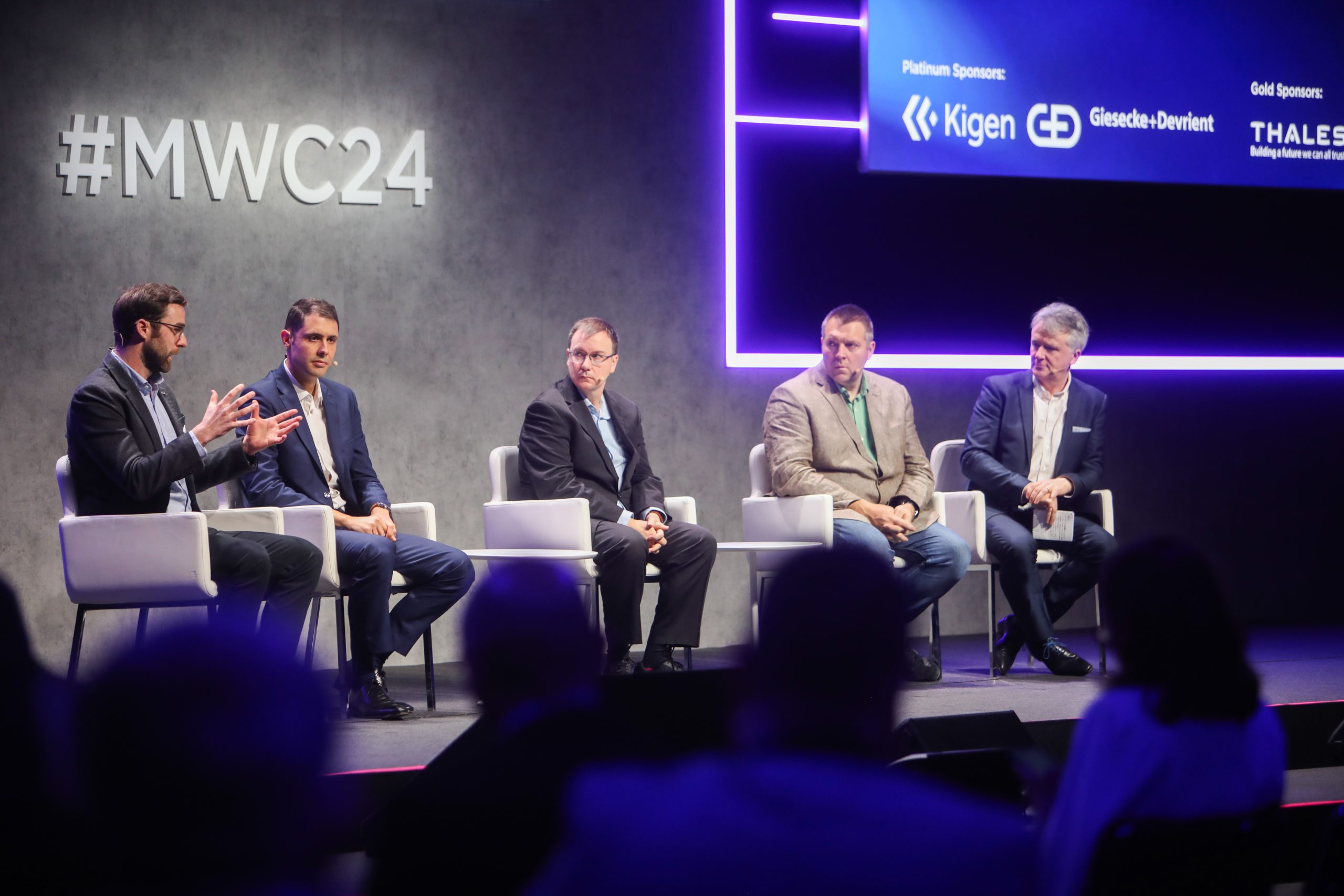
- Resources
- Blog
- News
Highlights of MWC Barcelona 2024
GSMA MWC Barcelona 2024 has again delivered four days of vibrant discussion and networking, convening industry leaders and attendees across the mobile ecosystem. With over 90,000+ attendees, it showcased how the telecoms sector can grow as an ecosystem and leverage the opportunity within the convergence of many technologies now catalyzing digital transformation with IoT, AI, and ML – through devices, services, and experiences.
For Kigen, the event also doubled as a fantastic proof point of how our partner ecosystem is pushing ahead on what matters to drive this growth, engaging in pivotal discussions to transform consumer, IoT, and industrial eSIM solutions. Kigen and partners made announcements throughout the show, releasing new developments that go hand in hand to show how eSIM and iSIM momentum is building.
In the lead-up to the show, Kigen had been making waves around driving pragmatic approaches to pre-standard readiness for the GSMA SGP.32 – aka the new eSIM specification for constrained IoT devices that simplifies Remote SIM Provisioning and management of large fleets. Lead-up to the show, Kigen had been making waves around driving pragmatic approaches to pre-standard readiness for SGP.32 – aka the new eSIM specification for constrained IoT devices that simplifies Remote SIM Provisioning and management, as available with Teal.
Throughout MWC Barcelona 2024, eSIM for IoT (SGP.32) remained a key area of discussion and demand. Other big technology disruptors, unsurprising, were AI, the evolving nature of Private networks, and the emergence of Satellite NTN connectivity.
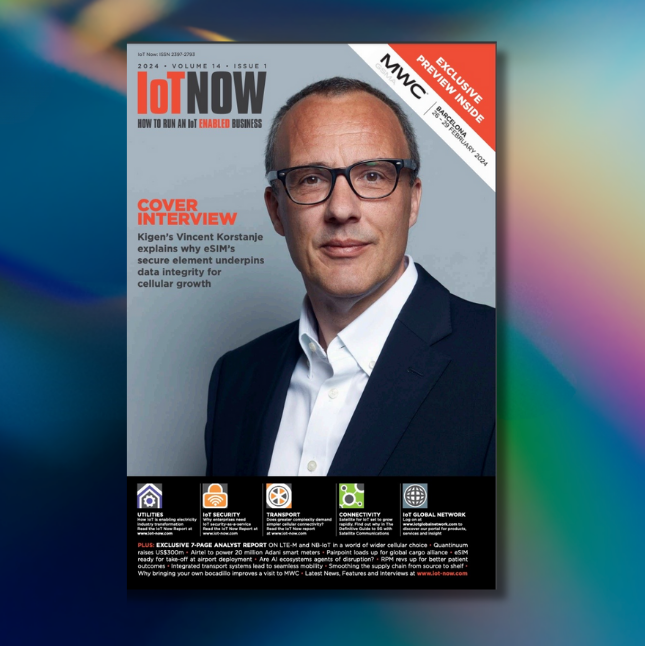


Ahead of the MWC 2024 Barcelona, Vincent Korstanje elaborated more on how data integrity from eSIM supports the overall cellular market growth with George Malim in the special edition of IoT NOW, the official publication of MWC Barcelona 2024.
To read the full article, download it here for free.
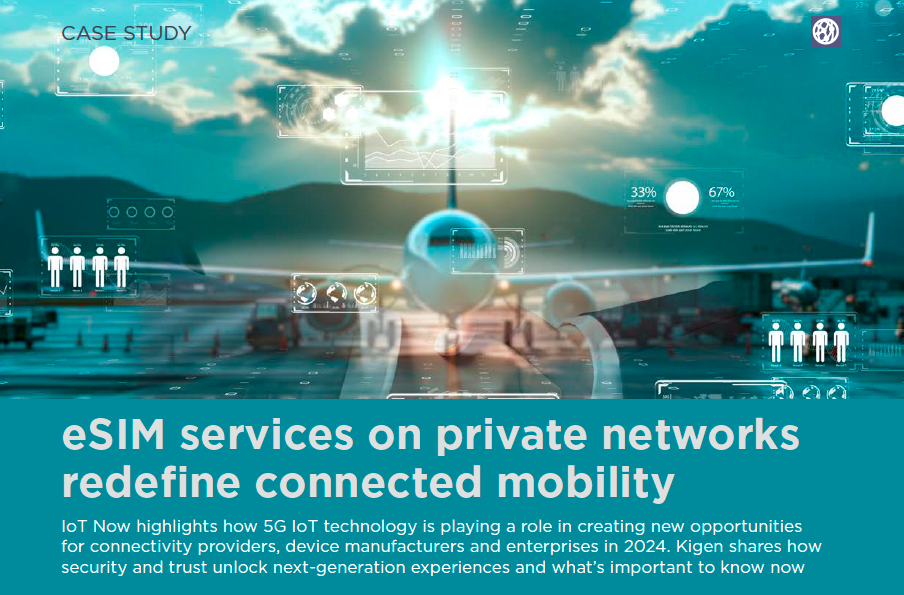


We also cast a light on a customer case study of eSIM-enabled solutions for Connected Airport redefining connectivity experience as they digitalise their operations with connected assets, connected operations, maximizing security and planning for control in the next generation of wireless infrastructure upgrades.
Back to eSIM, in the days leading up to the show, GSMA Intelligence released the latest edition in the Global Mobile Trends series for 2024. This Global Mobile Trends report examines the most significant developments expected in 2024. These include 5G’s next wave, the impact of generative AI, 5G-Advanced, new experiences from 5G-enabled services such as FWA, the future of entertainment, cloud, and edge computing, private wireless, eSIM, the rise of satellites, and sustainability strategies.
This comprehensive report draws on GSMA Intelligence data, survey findings and industry conversations to focus on the trends that matter most and what they mean for those in telecoms and beyond.
GSMA Intelligence: 5G FWA, eSIM, AI and NTN as key trends
A survey informed GSMA’s flagship research report of 100 operators globally to understand their views on three main areas of eSIM. When operators speak to their enterprise customers about the benefits of eSIM for IoT deployments, security and scalability are the eSIM benefits most often included in their conversations to drive interest in eSIM deployments.
There is a consensus among operators that enterprise demands for eSIM-enabled solutions will grow across most industries during 2024–2025, with Smart Cities leading the way with solutions such as eSIM-enabled smart metering. Looking further ahead, operators expect eSIM to account for 37% of the total cellular IoT connections by 2030, followed by the integrated SIM (iSIM) at 34% and the traditional removable SIM at 29%.
The survey result confirmed that managing large fleets of devices, subscription management, remote patch of devices, and device-to-cloud or chip-to cloud security are top value indicators for enterprise adoption of eSIM.



Another critical question the report asked: Will 5G FWA grow beyond a niche service?
The increasing availability and affordability of 5G FWA CPE and innovative tariffs are boosting the outlook for FWA globally. This is especially true for those areas characterized by low penetration of fiber (including emerging markets but also rural and remote areas in developed countries).
Kigen is proud to have supported this insightful report and made a copy of the eSIM trend report available along with the other key trends. Get your exclusive copy here.[CTA to get report]
Simplex Wireless and Kigen work to deliver on the eSIM Promise
The eSIM promise is to allow remote over-the-air changing of the connectivity provider to avoid carrier lock-in and give flexibility in choosing a provider based on the condition that suits the solution maker or OEM.
As we detailed in a previous blog, the eSIM Service Management functionality has been decoupled from the Connectivity Service Provider function with the new specification. The Solution Maker will have an eSIM Service Management Provider (eSMP) independent from their CSP. They can negotiate contracts with one or many CSPs and make the eSIMs available through their EIM server.
This is the most sought-after feature of eSIM from the perspective of Solution Makers. The spec will allow a standard mechanism for the ecosystem to work together, and the MNOs will be able to provide services more cost-effectively in eSIMs.
One of the most significant changes introduced by the IoT eSIM specification was the SIM card (eUICC) based IPA client (IPAe). The OEM independence it brings is enormous for the IoT ecosystem.
Simplex Wireless is working together with Kigen to use their SIM card (eUICC) based IPAe (available on Kigen IOT (SGP.32) OS-powered cards) to communicate with the Simplex EIM server. This showcases the flexibility of the new specifications for the solution makers to deploy IoT devices and switch eSMP providers.
Simplex Wireless is both an eSMP and a CSP. They provide these services independently, meaning that a Solution Maker can acquire either Simplex Wireless’ eSIM Management as a Service or eSIMs or both, in whatever way fits their choosing.
Based on these points, it is clear why the industry is so excited about the new specifications coming to market and why SIM card-based eSIM management is crucial.
The new eSIM for IoT Spec – SGP.32: 3rd time lucky
The GSMA SGP.31/32 specifications released in 2023 was a hot topic at the 5G IoT Summit. This new specification results from a multi-year industry collaboration to address critical challenges in remote management: we commend this joint effort at the GSMA and thank all involved, especially Kigen’s Saïd GHAROUT, who have been instrumental in its formation.
SGP.32 key benefits:
✔️ Openness: any IoT eSIM can download any profile from any operator DP+ without the complex integration
✔️ Designed for LPWAN devices: flexible protocol support to download profiles over constrained bearers such as NB-IoT or LTE-M
✔️ Flexibility in remote management models: eIM “remote control” could be operated by many parties and changed on the fly.
These have tremendous benefits for securing the future with AI, too – with IoT SAFE and the new SGP.42 for mass provisioning of profiles in factories.
Turning opportunities into a focus on scaling IoT
Kigen in conjunction with the GSMA IoT Marketing team, was proud to bring the 5G IoT Summit: this edition especially was timely this year with the theme of “Making IoT work for customers.”
Vincent Korstanje focused his keynote on “Scaling IoT,” covering key challenges and learnings from customers, particularly device makers, and OEMs, pinpointing:
📌 Deploying in volume: smart metering
📌 Scaled manufacturing “globally deployed, locally connected” devices – In Factory Profile Provisioning with eSIM
📌 Securing for AI: scaled security by design for inputs
Thanks to the strong design-in momentum of Kigen eSIM OS, we could share real customer success examples and one of our latest design wins, the Ulefone Ultra 23 Armor, using the Kigen eSIM and Skylo Technologies NTN network. Joining in the insights on joint learnings on simplifying the eSIM journey was Cameron Coursey from AT&T Business Connected Solutions, highlighting how our collaboration is
🔹 Streamlining certification
🔹 Supporting with simplified hardware options
🔹 Simplifying secure provisioning
We also raised awareness and are looking for support for the very impactful work of unconnected.org during the summit.
Cellular devices in the long tail, massive growth IoT still face two challenges for scaled deployments:
- For the device maker to build a single SKU and embed appropriate connectivity for the target market the device is destined for in the factory
- How a device in the field can securely activate the relevant eSIM subscription
Kigen has been addressing both challenges through In-factory profile provisioning (IFFP) and working with the GSMA for its eSIM discovery service.
IFFP is a relatively new technology that enables network operators and OEMs to provision eUICC profiles during device manufacturing. This allows devices to be shipped with one or more pre-provisioned profiles, which the end user can activate. A report from Transforma Insights elaborates more on the IFFP approach taken by Kigen and notes:
“Not only does In-Factory Profile Provisioning (IFFP) deliver maximum value to original equipment manufacturers OEMs by streamlining the assembly line production process, but it also ensures out-of-the-box connectivity into each piece of hardware, with the preferred local mobile network whenever needed.
Consequently, original equipment manufacturers (OEMs) using eSIM and IFPP can now streamline connectivity for large volumes of products, such as smart meters, logistics trackers, and smart wearables, before they are shipped to specific global destinations. In addition, eSIM and remote SIM provisioning allow users to switch networks in the field and integrate diverse IoT applications to suit their use case.”
— Matt Hatton, Transforma Insights



Download the report here to find out how IFPP accelerates device manufacturing.
IFPP offers reduced costs to the OEM with a single SKU, eliminating the need to ship devices with variants of eSIM and saving on shipping, logistics, and testing costs. It offers improved customer experience to activate devices and gives OEMs more flexibility with out-of-the-box connectivity without human intervention.
The process can be offline or online to suit the broadest range of manufacturing setups and profile loading times. As IFPP can occur on manufacturing sites outside of GSMA SAS certification, it offers reduced administration and cost compared to a standard SM-DP+ implementation.
Next, when a device is in the field and end-users need to activate it without worrying about obtaining a SIM or eSIM – this can often prove challenging. GSMA has been working to streamline subscriptions from MNO to the device to provide a smooth onboarding experience for all. Kigen participates in this effort and is enlisted as an approved GSMA SM-DP+ service provider!
The GSMA Discovery service is the tried and tested, GSMA standardized way of securely activating eSIM subscriptions when a device is first switched on and needs to connect to the mobile network operator of choice. The discovery service matches the eSIM using the EID identifier on the eUICC with the relevant operator’s eSIM profile.
That’s a wrap!
What were your highlights from MWC’24?
Let us know by joining the #FutureofSIM conversation on LinkedIn or Twitter.

